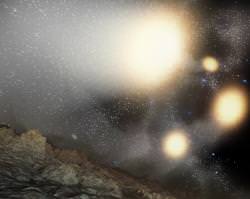Galaxies aren’t born, they evolve, getting built up through a succession of mergers over billions of years. In most cases, this process is slow and steady, with galaxies tearing apart their satellite neighbours and gaining mass. But in one cosmic collision seen by NASA’s Spitzer Space Telescope, 4 extremely massive galaxies are coming together at the same time in a cosmic pileup.
These merging galaxies aren’t small either. No, when this collision is all wrapped up, the remaining monster galaxy will have 10 times the mass of our Milky Way – one of the largest galaxies in the entire Universe. We’ll have a taste of this in about 5 billion years, when the Milky Way merges with Andromeda.
Regular mergers are very common across the Universe; it’s how galaxies grow. But this is different. Bigger, more massive, more destructive. Here’s a cool quote from one of the discovering scientists:
“Most of the galaxy mergers we already knew about are like compact cars crashing together,” said Kenneth Rines of the Harvard-Smithsonian Center for Astrophysics, Cambridge, Mass. “What we have here is like four sand trucks smashing together, flinging sand everywhere.”
It’s inevitable that the most massive galaxies in the Universe will collide and merge too, they’ve just never been seen before.
Galaxy collisions are one of the events that can ignite star formation. The gravitational interaction between galaxies causes clouds of gas and dust to collapse, creating new stellar nurseries. But that won’t happen here. Spitzer didn’t see large quantities of gas, and hot, young star formation; only old stars.
Original Source:NASA News Release

